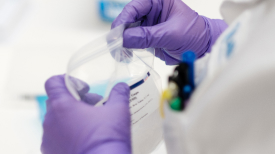- Cancer Care Team
Cancer Care Team
To deliver optimal patient outcomesProducts and Services
Cancer Type
Supplies & Tools
Scientific Focus
- Biopharma Partners
- Patients
- Education & Events
- Login
- Contact Us
Test Details
 Cancer Type
Cancer Type
Brain, Glioblastoma
 Technology Used
Technology Used
Molecular
 Turnaround Time
Turnaround Time
5 - 7 days
Use
Telomerase reverse transcriptase (TERT) is the rate-limiting catalytic subunit of telomerase, which maintains telomere length. The two most commonly impacted sites for TERT promoter mutations are located 124 and 146 base pairs upstream from the translational start site, and generate C to T transitions (-124C>T and -146C>T). These two hotspots comprise 100% of the mutations reported in glioma, and >98% of the mutations detected in the TERT promoter across all tumor types. TERT promoter mutations create novel binding sites for ETS/TCF family of transcription factors such as GA Binding Protein Transcription Factor Subunit Alpha (GABPA) and increase TERT expression ~2-6 fold. The -146C>T mutation also creates a binding site for non-canonical NF-KB subunit p52 and ETS1/2.
Somatic mutations in the TERT promoter have been shown to cause TERT upregulation in a wide range of solid cancers, including central nervous system tumors, melanoma, urothelial carcinoma, poorly differentiated and anaplastic thyroid carcinomas, cutaneous basal cell and squamous cell carcinomas, and hepatocellular carcinoma. In glioma and glioblastoma multiforme (GBM), the frequency of TERT promoter mutations varies by WHO grade. Assessment of TERT promoter mutation status, in addition to IDH mutations and 1p/19q co-deletion, could help refine the WHO 2016 classification of gliomas in diagnosis and allow for precise clinical management of the patients.
Special Instructions
Please provide a copy of the pathology report. TERT testing will be delayed if the pathology report is not received. Please direct any questions regarding this test to customer service at 800-345-4363.
Limitations
In vitro studies indicate that this assay has a sensitivity to detect approximately 5% mutated TERT in a background of non-mutant DNA. Mutations present at a level below the detection sensitivity or outside the analyzed region of the TERT genes will not be detected by this assay.
This test was developed and its performance characteristics determined by Labcorp. It has not been cleared or approved by the Food and Drug Administration.
Methodology
Genomic DNA was isolated from the provided tumor specimen. The promoter region of TERT gene was subjected to SNaPshot multiplex PCR and primer extension for mutation detection. This assay is able to detect 5% mutation in a background of wild-type DNA. This test can detect the following hotspot mutations in the TERT promoter: -146C>T (C250T) and -124C>T (C228T).
Related Documents
References
Bell RJA, Rube HT, Xavier-Magalhaes A, et al. Understanding TERT Promoter Mutations: A Common Path to Immortality. Mol Cancer Res. 2016 Apr;14(4):315-323.26941407
Eckel-Passow JE, Lachance DH, Molinaro AM, et al. Glioma Groups Based on 1p/19q, IDH, and TERT Promoter Mutations in Tumors. N Engl J Med. 2015 Jun 25;372(26):2499-2508.26061753
Hafezi F, Bercoff DP. The Solo Play of TERT Promoter Mutations. Cells. 2020 Mar 19;9(3):749.32204305
Killela PJ, Reitman ZJ, Jiao Y, et al. TERT promoter mutations occur frequently in gliomas and a subset of tumors derived from cells with low rates of self-renewal. Proc Natl Acad Sci U S A. 2013 Apr 9;110(15):6021-6026.23530248
National Comprehensive Cancer Network (NCCN). Central Nervous System Cancers: NCCN Guidelines Version 2.2020.
Patel B, Taiwo R, Kim AH, Dunn GP. TERT, a promoter of CNS malignancies. Neurooncol Adv. 2020 Jan-Dec;2(1):vdaa025.32226942
Pekmezci M, Rice T, Molinaro AM, et al. Adult infiltrating gliomas with WHO 2016 integrated diagnosis: additional prognostic roles of ATRX and TERT. Acta Neuropathol. 2017 Jun;133(6):1001-1016.28255664
Thomas NE, Edmiston SN, Tsai YS, et al. Utility of TERT Promoter Mutations for Cutaneous Primary Melanoma Diagnosis. Am J Dermatopathol. 2019 Apr;41(4):264-272.30211730
Vinagre J, Almeida A, Pópulo H, et al. Frequency of TERT promoter mutations in human cancers. Nat Commun. 2013;4:2185.23887589
Walsh KM, Wiencke JK, Lachance DH, et al. Telomere maintenance and the etiology of adult glioma. Neuro Oncol. 2015 Nov;17(11):1445-1452.26014050
Specimen Requirements
Information on collection, storage, and volume
Specimen
Paraffin-embedded (FFPE) tissue block or slides
Volume
Paraffin-embedded tissue (FFPE) block
Minimum Volume
Two unstained slides at 5µm and one matching H&E slide or three unstained slides at 5µm. Tumor surface area ≥ 4mm2 tumor area and ≥ 50% tumor content are preferred.
Container
FFPE tissue block and slide container
Storage Instructions
Maintain FFPE blocks/slides at room temperature.
Causes for Rejection
No tumor tissue in FFPE block or slides; broken or stained slides
Related Tests
Find more tests related to this one.





